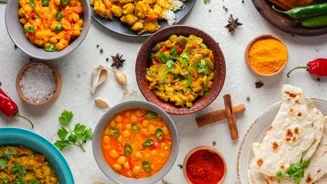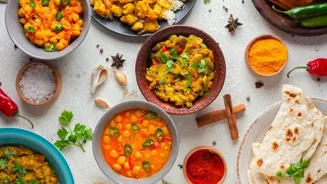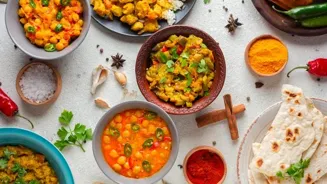Explore 10 Traditional Indian Dishes for Festivals. Discover rich flavors and cultural significance
India, a land of vibrant culture and diverse traditions, celebrates numerous festivals and special occasions
throughout the year. Food is an integral part of these celebrations, with each region boasting its unique delicacies passed down through generations.
These dishes are not just about taste; they represent heritage, togetherness, and the spirit of festivity. Let's explore 10 traditional vegetarian Indian dishes that are perfect for adding a touch of authenticity and deliciousness to your celebrations.
Modak (Maharashtra)
No Ganesh Chaturthi celebration is complete without modak. These sweet dumplings are believed to be Lord Ganesha's favorite treat. The traditional recipe involves a filling of grated coconut and jaggery, encased in a soft rice flour dough.
Steamed to perfection, modaks are a delightful offering and a must-have delicacy during the festival. The aroma of freshly steamed modaks fills homes, creating a festive atmosphere. Making modaks together is a family affair, strengthening bonds and preserving tradition.
Many variations exist today, from chocolate modaks to fried modaks, but the classic steamed version remains the most cherished. This dish truly embodies the spirit of Ganesh Chaturthi, highlighting the cultural significance of food in Indian celebrations.
This sweet dish also symbolizes prosperity and good fortune. Sharing the love of Modak with family and friends during celebrations makes the event more memorable.
Puran Poli (Maharashtra/Gujarat)
Puran Poli, a sweet flatbread, is a staple during festivals like Holi and Diwali in Maharashtra and Gujarat. It consists of a sweet lentil filling (puran) made from chana dal (split chickpeas), jaggery, and spices, stuffed inside a whole wheat flour dough and then roasted on a griddle with ghee.
The result is a warm, comforting, and flavorful treat that is enjoyed by people of all ages. These are generally made at home by people and served hot while celebrating various festivals. The lentil filling provides a good source of protein, making it a healthy and satisfying dessert.
Puran Poli symbolizes prosperity and abundance, often prepared to celebrate new beginnings and harvests. The process of making Puran Poli requires patience and skill, passed on through generations of home cooks.
Payasam/Kheer (Pan India)
Payasam, also known as Kheer in North India, is a classic Indian rice pudding that is a must-have for any festive occasion. Made with rice, milk, sugar, and flavored with cardamom, nuts, and saffron, it's a creamy, rich, and aromatic dessert that tantalizes the taste buds.
Payasam is not just a dessert; it's an offering to the gods and a symbol of auspicious beginnings. Each region has its own unique twist on the recipe, with variations including vermicelli payasam, moong dal payasam, and even carrot payasam.
Regardless of the variation, Payasam is always a crowd-pleaser and a perfect way to end a festive meal. It represents purity, sweetness, and the sharing of good fortune.
Pongal (Tamil Nadu)
Pongal, both the festival and the dish, holds immense significance in Tamil Nadu. The dish, also called Pongal, is a rice and lentil preparation that is cooked in a clay pot until it overflows, symbolizing abundance and prosperity.
There are two main variations: sweet pongal (Sakkarai Pongal) made with jaggery and savory pongal (Ven Pongal) made with spices and ghee. Pongal is traditionally offered to the Sun God during the Pongal festival, a harvest festival celebrated with great enthusiasm.
The act of letting the Pongal overflow from the pot is considered highly auspicious, signifying a bountiful harvest and good fortune for the coming year. This ritual, deeply rooted in agricultural traditions, reflects the connection between food, nature, and the festive spirit.
This dish is prepared using traditional methods for an authentic cultural experience.
Ladoo (Pan India)
Ladoo, a spherical sweet made from flour, sugar, and ghee (clarified butter), is one of the most popular and versatile Indian sweets.
It is made in a variety of flavors and textures, including besan ladoo (made from gram flour), motichoor ladoo (made from tiny fried gram flour balls), and rava ladoo (made from semolina).
Ladoos are an integral part of almost every Indian festival and celebration, from Diwali and weddings to birthdays and religious ceremonies. They symbolize good luck, happiness, and the sharing of sweet moments.
Offering laddoos is a gesture of goodwill and is believed to bring auspiciousness to any occasion. The sheer variety of ladoos available across India reflects the culinary diversity of the country. They are easy to distribute among guests and mark any auspicious event.
Gujiya (Rajasthan/Uttar Pradesh)
Gujiya, a sweet dumpling filled with khoya (milk solids), dried fruits, and nuts, is a popular treat during Holi, the festival of colors. The dough is made from flour and ghee, rolled out into small circles, filled with the sweet mixture, and then sealed and deep-fried until golden brown.
Gujiyas are often decorated with intricate designs and can be stored for several days, making them perfect for sharing with family and friends during the festive season. These handmade sweets are a symbol of joy, celebration, and the warmth of family gatherings.
The process of making gujiyas is often a collaborative effort, with family members coming together to fill, shape, and fry these delightful treats. The crispy outer layer and the sweet, nutty filling make gujiyas an irresistible indulgence.
Halwa (Pan India)
Halwa, a sweet pudding made from various ingredients like semolina (rava), wheat flour (atta), carrots (gajar), or lentils (moong dal), is a comforting and versatile dessert that is popular across India. Usually garnished with nuts, the halwa is often cooked with ghee, milk, and sugar.
Each region has its unique variation, with slight changes in ingredients and preparation methods. Halwa is often prepared for religious occasions, festivals, and even as a simple dessert for family gatherings. The warm, sweet and nutty taste of Halwa makes it a good choice on cool evenings.
It is seen as a symbol of prosperity and hospitality, offering a welcoming and satisfying end to any meal.
Mysore Pak (Karnataka)
Mysore Pak, a rich and melt-in-your-mouth fudge made from gram flour, ghee, and sugar, is a specialty of Karnataka. This decadent sweet is believed to have originated in the Mysore Palace and is a popular treat during festivals and special occasions.
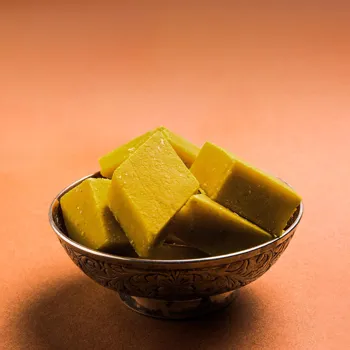
The careful balance of ingredients and the specific cooking technique are crucial to achieving the perfect texture – a slightly porous and crumbly exterior with a rich and ghee-laden interior. Mysore Pak is often gifted during festivals as a symbol of luxury and indulgence.
Its rich and distinctive flavor makes it an unforgettable treat and a highlight of any festive spread. Sharing the sweetness and richness associated with Mysore Pak demonstrates goodwill and generosity.
Kesar Pista Shrikhand (Gujarat/Maharashtra)
Shrikhand, a creamy and refreshing dessert made from hung curd (yogurt), sugar, and flavored with cardamom and saffron, is a popular choice during summer festivals in Gujarat and Maharashtra.
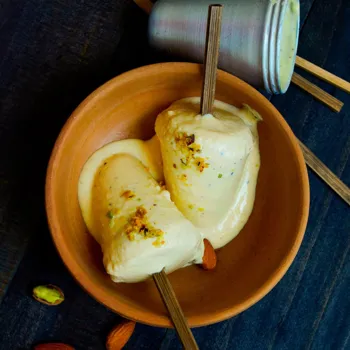
The addition of Kesar (saffron) and Pista (pistachios) elevates this simple dessert, adding a touch of luxury and flavor. Its cooling properties make it a perfect treat for hot weather and it is believed to be good for digestion.
Shrikhand is often served with poori (deep-fried bread) or as a standalone dessert. Its light and refreshing flavor and delightful texture make it a perfect ending to the festive meal. Saffron and cardamom are considered auspicious and make the dessert a good selection for festival celebrations.
Sabudana Khichdi (Pan India, especially Maharashtra & Gujarat during fasting)
Sabudana Khichdi, a savory dish made from soaked sabudana (tapioca pearls), potatoes, peanuts, and spices, is a popular fasting food during festivals like Navratri and Shivratri. This dish provides sustained energy during fasting periods and is also delicious and satisfying.
It is usually seasoned with green chilies, coriander, and lemon juice, adding a tangy and fresh flavor to the dish. Sabudana Khichdi is a great example of how simple ingredients can be transformed into a flavorful and nutritious meal.
It is light, easy to digest and provides the necessary energy to sustain one while fasting. The dish represents simplicity, devotion, and the adaptation of traditional foods to specific dietary needs.
These 10 traditional Indian vegetarian dishes provide a glimpse into the rich culinary heritage of India and are perfect for celebrating festivals and special occasions.
They are not just about satisfying your hunger; food symbolizes culture tradition and togetherness, enhancing the spirit of festivity and creating lasting memories. So, this festive season, try your hand at making some of these delicacies and share the joy of Indian cuisine with your loved ones.

